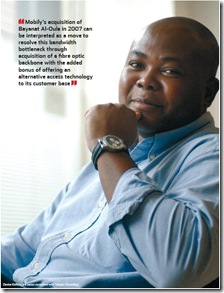
The phenomenal subscription growth across the Middle East over recent years has seen with it an acceleration in network rollout and coverage as operators rush to meet the capacity needs of their growing subscriber base.
Devine Kofiloto is a senior consultant with Teleplan Consulting.
The subsequent increase in voice traffic and the take-up of wireless broadband will see backhaul, transmission and core networks come under further strain. In a region where many of the operators do not have adequate wireline infrastructure in place to backhaul cellular traffic, this bottleneck will become all the more pronounced with the current focus on data centric networks and the move towards converged service offerings.
Perhaps it comes as no surprise that HSDPA deployments in spite of their successful take-up rates in the major Gulf states are still largely confined to the major cities and have yet to see nationwide deployments. In general, operators’ focus has been on upgrading the access portion of their networks in order to drive usage and traffic, offering multiple access technologies such as EDGE, WCDMA, HSDPA (and more recently WiMAX) simultaneously on their networks.
Backhaul has not received as much attention. As data rates continue to improve with higher upload speeds from 3.6Mbps to 7.2Mbps and beyond, we are bound to witness a further acceleration in the take-up and adoption of more data hungry applications. Though the time frame for this anticipated growth in traffic is likely to be in the medium to long term, there is always the risk of underestimation. In contrast to the more mature markets where the wireline alternative will also absorb some of this surge in traffic volume and its subsequent capacity increase, in the Middle East this will largely fall to wireless infrastructure.
Though not likely to apply to greenfield operations, existing backhaul infrastructure is generally comprised of legacy solutions primarily designed to support voice traffic and therefore scale at a very high cost in order to handle bandwidth intensive data traffic.
Across Europe where mobile broadband has become a reality, the issue of bandwidth constraint is already catching up with the continent’s pure play mobile operators. The combination of plug and play USB modems and the availability of monthly flat rate tariffs have seen operators take up head to head competition with fixed-line operators for a share of the broadband market.
Experience so far, especially from Austria and Portugal, shows mobile broadband making significant gains over fixed line counterparts for the share of broadband net adds. Relying mainly on E1 lines for backhaul, the gathering momentum of mobile data is bringing along with it capacity issues. The need to build capacity redundancy, in future, appears to be dictating some mobile operators’ acquisition strategies.
Pure mobile play operator, Vodafone, is now moving to own fibre with its strategy to offload HSPA via DSL. Vodafone’s recent acquisition of Tele2’s wireline assets in Italy and France is evidence of this emerging trend. In Portugal, a market where mobile broadband net adds accounted for more than half the total broadband adds in 2007, Vodafone has gone on to deploy DSL. Investments in wireline will most likely make room for operators to offer their heavy mobile broadband users fixed alternatives so as to address their network problems.
Within the region, the move in this direction might have already begun. Mobily’s acquisition of Bayanat Al-Oula in 2007 can be interpreted as a move to resolve this bandwidth bottleneck through acquisition of a fibre optic backbone with the added bonus of offering an alternative access technology to its customer base. With Bayanat Al-Oula’s WiMAX network, Mobily can now offer broadband to its customers over both HSDPA and WiMAX, with a backbone to handle any consequent upsurge in future traffic volumes.
The alternatives for operators are many, but the challenge is in finding a cost effective solution so as to reduce the delivery cost per Mbit. In the interim, operators can look to solutions that optimise bandwidth and manage networks in congested situations, but in the longer term where do they go from here? Leasing capacity already accounts for almost 30 per cent of operators’ operational expenditure. Increasing leased capacity can only increase this expenditure, making it a less cost effective alternative.
Moreover leased capacity leaves the operator reliant on its wireline counterpart, usually the fixed line incumbent. Microwave links also offer an alternative, though limited spectrum remains an issue.
Investing in their own optical fibre transmissions would be the most reliable approach to support high speed data. However not only is this costly, it can also be difficult and challenging in already built-up areas.
An editorial by Devine Kofiloto, senior consultant with Teleplan Consulting





0 comments ↓
There are no comments yet...Kick things off by filling out the form below.
Leave a Comment